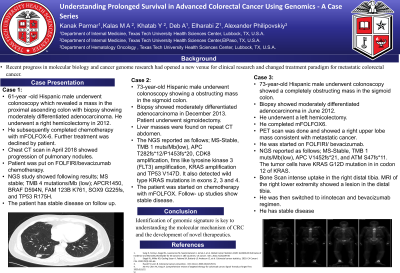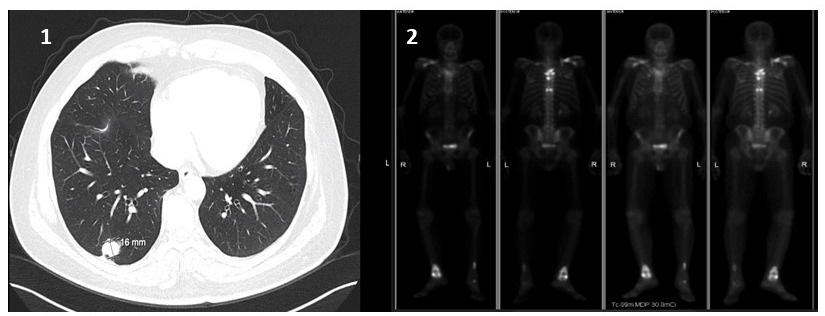Back


Poster Session D - Tuesday Morning
Category: Colon
D0146 - Understanding Prolonged Survival in Advanced Colorectal Cancer Using Genomics: A Case Series
Tuesday, October 25, 2022
10:00 AM – 12:00 PM ET
Location: Crown Ballroom

Has Audio

Kanak Parmar, MBBS
Texas Tech University Health Sciences Center
Lubbock, Texas
Presenting Author(s)
Kanak Parmar, MBBS1, M Ammar Kalas, MD2, Yacoub Khatab, MS3, Anasua Deb, MD, PhD1, Zeyad Elharabi, MD4, Alexander Philipovskiy, MD1
1Texas Tech University Health Sciences Center, Lubbock, TX; 2Texas Tech University Health Sciences Center, El Paso, TX; 3Paul L. Foster School of Medicine - Texas Tech University Health Sciences Center, El Paso, TX; 4TTUHSC, Lubbock, Lubbock, TX
Introduction: Recent progress in molecular biology and cancer genome research had opened a new venue for clinical research and changed treatment paradigm for metastatic colorectal cancer.
Case Description/Methods: Case 1:
A 61-year -old Hispanic male underwent colonoscopy which revealed an mass in the proximal ascending colon with biopsy showing moderately differentiated adenocarcinoma. The patient underwent a right hemicolectomy in 2012. He subsequently completed chemotherapy with mFOLFOX-6. Further treatment was declined by patient. Follow up chest CT scan in April 2018, uncovered progression of pulmonary nodules. Patient was put on FOLFIRI/bevacizumab chemotherapy. NGS study showed following results; MS stable; TMB 4 mutations/Mb (low); APCR1450, BRAF D594N, FAM 123B K761, SOX9 G225fs, and TP53 R175H.The patient has stable disease on follow up.
Case 2:
A 73-year-old Hispanic male underwent colonoscopy showing a obstructing mass in the sigmoid colon. Biopsy showed moderately differentiated adenocarcinoma in December 2013. Patient underwent sigmoidectomy. Liver masses were found on repeat CT abdomen. The NGS reported as follows; MS-Stable, TMB 1 muts/Mb(low), APC T282fs*12/P1453fs*20, CDK8 amplification, fms like tyrosine kinase 3 (FLT3) amplification, KRAS amplification and TP53 V147D. It also detected wild type KRAS mutations in exons 2, 3 and 4. The patient was started on chemotherapy with mFOLFOX. Follow- up studies show stable disease.
Case 3:
A 73-year-old Hispanic male underwent colonoscopy showed a completely obstructing mass in the sigmoid colon. Biopsy showed moderately differentiated adenocarcinoma in June 2012. The tumor cells have KRAS G12D mutation in in codon 12 of KRAS. He underwent a left hemicolectomy. He completed mFOLFOX6.PET scan was done and showed a right upper lobe mass consistent with metastatic cancer. He was started on FOLFIRI/ bevacizumab. NGS reported as follows; MS-Stable, TMB 1 muts/Mb(low), APC V1452fs*21, and ATM S47fs*11. Bone Scan intense uptake in the right distal tibia. MRI of the right lower extremity showed a lesion in the distal tibia. He was then switched to irinotecan and bevacizumab regimen. He has stable disease.
Discussion: Identification of genomic signature is key to understanding the molecular mechanism of CRC and the development of novel therapeutics.

Disclosures:
Kanak Parmar, MBBS1, M Ammar Kalas, MD2, Yacoub Khatab, MS3, Anasua Deb, MD, PhD1, Zeyad Elharabi, MD4, Alexander Philipovskiy, MD1. D0146 - Understanding Prolonged Survival in Advanced Colorectal Cancer Using Genomics: A Case Series, ACG 2022 Annual Scientific Meeting Abstracts. Charlotte, NC: American College of Gastroenterology.
1Texas Tech University Health Sciences Center, Lubbock, TX; 2Texas Tech University Health Sciences Center, El Paso, TX; 3Paul L. Foster School of Medicine - Texas Tech University Health Sciences Center, El Paso, TX; 4TTUHSC, Lubbock, Lubbock, TX
Introduction: Recent progress in molecular biology and cancer genome research had opened a new venue for clinical research and changed treatment paradigm for metastatic colorectal cancer.
Case Description/Methods: Case 1:
A 61-year -old Hispanic male underwent colonoscopy which revealed an mass in the proximal ascending colon with biopsy showing moderately differentiated adenocarcinoma. The patient underwent a right hemicolectomy in 2012. He subsequently completed chemotherapy with mFOLFOX-6. Further treatment was declined by patient. Follow up chest CT scan in April 2018, uncovered progression of pulmonary nodules. Patient was put on FOLFIRI/bevacizumab chemotherapy. NGS study showed following results; MS stable; TMB 4 mutations/Mb (low); APCR1450, BRAF D594N, FAM 123B K761, SOX9 G225fs, and TP53 R175H.The patient has stable disease on follow up.
Case 2:
A 73-year-old Hispanic male underwent colonoscopy showing a obstructing mass in the sigmoid colon. Biopsy showed moderately differentiated adenocarcinoma in December 2013. Patient underwent sigmoidectomy. Liver masses were found on repeat CT abdomen. The NGS reported as follows; MS-Stable, TMB 1 muts/Mb(low), APC T282fs*12/P1453fs*20, CDK8 amplification, fms like tyrosine kinase 3 (FLT3) amplification, KRAS amplification and TP53 V147D. It also detected wild type KRAS mutations in exons 2, 3 and 4. The patient was started on chemotherapy with mFOLFOX. Follow- up studies show stable disease.
Case 3:
A 73-year-old Hispanic male underwent colonoscopy showed a completely obstructing mass in the sigmoid colon. Biopsy showed moderately differentiated adenocarcinoma in June 2012. The tumor cells have KRAS G12D mutation in in codon 12 of KRAS. He underwent a left hemicolectomy. He completed mFOLFOX6.PET scan was done and showed a right upper lobe mass consistent with metastatic cancer. He was started on FOLFIRI/ bevacizumab. NGS reported as follows; MS-Stable, TMB 1 muts/Mb(low), APC V1452fs*21, and ATM S47fs*11. Bone Scan intense uptake in the right distal tibia. MRI of the right lower extremity showed a lesion in the distal tibia. He was then switched to irinotecan and bevacizumab regimen. He has stable disease.
Discussion: Identification of genomic signature is key to understanding the molecular mechanism of CRC and the development of novel therapeutics.

Figure: Figure 1 (left) shows CT Chest for Case 1 with multiple pulmonary nodules few with cavitation, largest 9mm
Figure 2(right) shows Bone Scan for Case 3 in February 2021 with intense uptake in the right distal tibia
Figure 2(right) shows Bone Scan for Case 3 in February 2021 with intense uptake in the right distal tibia
Disclosures:
Kanak Parmar indicated no relevant financial relationships.
M Ammar Kalas indicated no relevant financial relationships.
Yacoub Khatab indicated no relevant financial relationships.
Anasua Deb indicated no relevant financial relationships.
Zeyad Elharabi indicated no relevant financial relationships.
Alexander Philipovskiy indicated no relevant financial relationships.
Kanak Parmar, MBBS1, M Ammar Kalas, MD2, Yacoub Khatab, MS3, Anasua Deb, MD, PhD1, Zeyad Elharabi, MD4, Alexander Philipovskiy, MD1. D0146 - Understanding Prolonged Survival in Advanced Colorectal Cancer Using Genomics: A Case Series, ACG 2022 Annual Scientific Meeting Abstracts. Charlotte, NC: American College of Gastroenterology.
